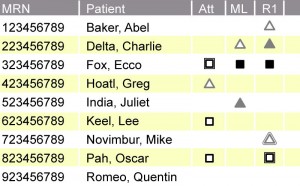- Scribes
- Visibility
- Speech Recognition
“Out of sight, out of mind.”
Ever heard the one about the early translation program that converted this aphorism into Chinese and then back? It came out as “invisible idiot.” Regardless, “out of sight, out of mind” is a good general psychological principle. In any nuclear power plant control station, air traffic control center, AWACS plane, aircraft cockpit, or any busy and confusing medical setting whether inpatient, outpatient or ED , people need to know what’s going on. It’s called situational awareness, and it is key to avoiding human error. And we need to keep unimportant stuff out of sight, and out of mind, so people can concentrate on what’s important.
But to keep nuclear reactor coolant pumps, aircraft, or patients in people’s minds, we put something in front of them. Even if it’s just a tiny blinking light, a text summary. or an icon of an airplane. That is why there are tracking systems, to which many of the essays on this site are devoted.
However, the principle applies in other settings, including medical charting.
I dictate many of my charts using a system from Nuance/Dictaphone called Enterprise Workstation. Indeed, in the ED, all of our physician charts, even those of rotating interns, have been done on this system for several years. (We’ve actually used speech recognition for all our charts for over ten years, using some predecessor systems.) It has been fairly succesful by many measures.
There are a few problems with it, including a klunky interface and the total lack of user interface upgrades for years, but one problem in particular stands out: chart completion. We have to have people tracking our charts. They are always emailing us about charts that we have
- forgotten to do, or
- left in self-edit mode (not yet signed), or
- there is an unsigned resident note (sometimes an attending physician will tell a resident not to dictate a chart as the attending has done a complete chart, but the resident goes ahead and dictates a note and the attending doesn’t know it exists).
We could save $$$ and lots of people’s time if only chart status was apparent to our docs and midlevels. The system should make charts visible, so we may form a mental model of our chart status:
- Do I have charts left over from previous shifts to complete?
- Which patients belong to me this shift?
- Which charts have been completed by a resident?
- Which charts have been completed by me?
Any charting system needs a tracking system, not for patients, but for tracking charts. Such a tracking system might look like this:
Here is the explanation, which I sent to Dictaphone in June 2009:
Please look at the attached picture (just a rough sketch in Adobe Illustrator, sorry if it’s a bit crude).
For charts you’ve “claimed” the triangles turn to squares.
This is from an attending’s view, things would look different for a resident, CRNP or PA.
The intern has started a note on Abel Baker but is not currently editing it.
The intern has finished a note on Charlie Delta and the R3 has started work on it.
The intern AND the R3 have finished their work on Ecco Fox’s note, and you’ve claimed it and have started editing (adding your attending note).- in fact, you only see this for a second after you’ve double- clicked on the line before the actual note pops up in front of you.
Some other attending has started a note on Greg Hoatl.
A midlevel of some sort (CRNP, R2 or R3 – I grouped them for simplicity) has finished a note on Juliet India, but no attending has claimed it yet.
You’ve started a note on Lee Keel but are not editing it right now.
The intern is editing Mike Novimbur’s note right now.
You and the intern are both seeing Oscar Pah; you’ve edited your attending note a bit, and the intern is currently editing.
You can click on any of the icons to edit a chart. If the chart is already open, you will be presented with an option to Cancel or to create a new chart. (If there are two charts for a particular patient, that line will double and it will have two rows of icons to indicate the two charts.)
The essential part of this is to make the relevant aspects of your list of charts visible, with nothing else cluttering the screen: “invisible idiot”.
Tags: Visibility, Emergency Department, Medical Charting, Computers, Charting, Tutorial, Usability, User Interaction Design, User Interface, Tracking System




